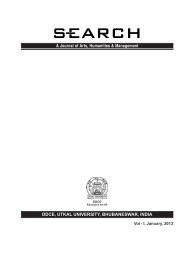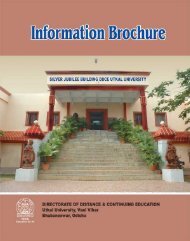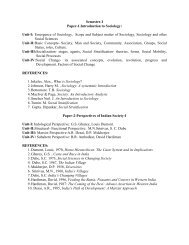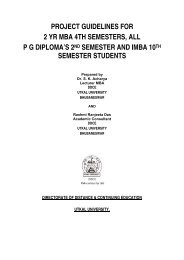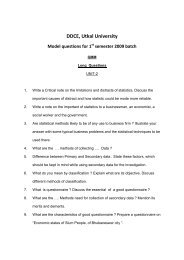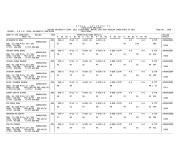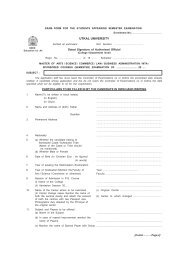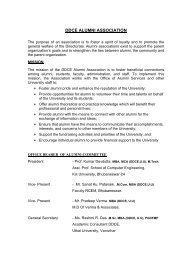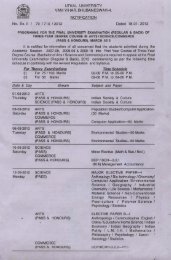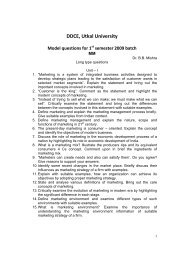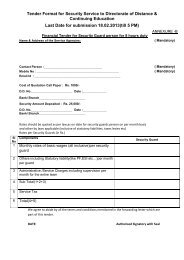REGULATION & SYLLABUS - DDCE, Utkal University, Bhubaneswar
REGULATION & SYLLABUS - DDCE, Utkal University, Bhubaneswar
REGULATION & SYLLABUS - DDCE, Utkal University, Bhubaneswar
Create successful ePaper yourself
Turn your PDF publications into a flip-book with our unique Google optimized e-Paper software.
tourism Marketing and Management Issues.<br />
Information System Management (Group D)<br />
1 DBMS & RDBMS<br />
Unit-1<br />
Database: Introduction, database system applications, database systems versus file systems,<br />
view of date, data models, database language, database users and administrators.<br />
Unit-2<br />
Entity relationship models: basic concepts, constraints, keys, design issues, entity relationship<br />
diagram, weak entity sets, design of an E-R database scheme, reduction of and E-R scheme of<br />
tables, Database structure- network database structure- relational database structure-hierarchical<br />
database structure, The server architecture, distributed processing, distributed database.<br />
Unit-3<br />
Relational-database design: First normal form, pitfalls in relational database design, functional<br />
dependencies, decomposition, desirable properties of decomposition, Boyce-code normal for,<br />
third normal form, fourth normal form, more normal forms.<br />
Unit-4<br />
Storage and file structure; overview of physical storage media, magnetic disks, RAID, storage<br />
access, file organisation, organisation of records in files, data-dictionary storage.<br />
Unit-5<br />
Query processing and optimisation; overview, measure of query cost, selection operation, sorting,<br />
join operator, evaluation of expressing.<br />
Reference Studies<br />
1.Panneer lelam –Database Management Systems – PHI.<br />
2.Hansen & Hansen –Database Management & Design –PHI<br />
3.“Simplified Approach to DBMS” Parteek Bhatia , Gurvinder Singh. Kalyani Pub.<br />
2 Enterprise Resource Planning<br />
Unit - 1<br />
Enterprise Resources Planning: Evolution of ERP-MRP and MRP II – problems of system islands,<br />
need for system integration and interface, early ERP Packages, ERP products and Markets,<br />
Unit - 2<br />
Opportunities and problems in ERP selection and implementation: ERP implementation: identifying<br />
ERP benefits team formation, Consultant intervention, Selection ERP, Process of ERP implementation,<br />
Managing changes in IT organization Preparing IT infrastructure, Measuring benefits<br />
of ERP,<br />
Unit - 3<br />
Integrating with other systems: Post ERP, Modules in ERP, Business Modules of ERP Package,<br />
Reengineering Concepts, The emergence of reengineering concept- concept of business process,<br />
rethinking of processes, identification of re-engineering need, preparing for re-engineering<br />
Unit - 4<br />
Implementing change, change management, BPR & ERP, Supply Chain Management: The concept<br />
of value chain differentiation between ERP and SCM, SCM for customer focus, need and<br />
specificity of SCM-SCM scenario in India, products and markets of Sehi, issues in selection and<br />
implementation of SCM solutions, CRM solution,<br />
Unit - 5<br />
E-Business; Introduction to 1.Net technologies, Evolution of E-Commerce, EDI and E Business,<br />
Business opportunities, Basic and advanced business models on internet , internet banking and<br />
related technologies, security and privacy issues, technologies for E- Business, Future and Growth<br />
of E-Business.



